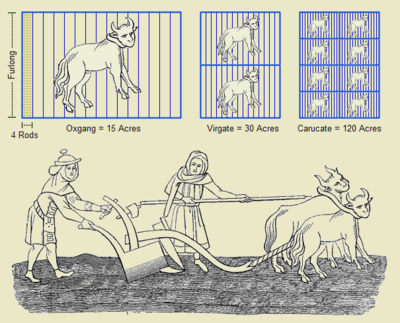Oxgang facts for kids

- The rod is a historical unit of length equal to 5+1⁄2 yards. It may have originated from the typical length of a mediaeval ox-goad. There are 4 rods in one chain.
- The furlong (meaning furrow length) was the distance a team of oxen could plough without resting. This was standardised to be exactly 40 rods or 10 chains.
- An acre was the amount of land tillable by one man behind one ox in one day. Traditional acres were long and narrow due to the difficulty in turning the plough and the value of river front access.
- An oxgang was the amount of land tillable by one ox in a ploughing season. This could vary from village to village, but was typically around 15 acres.
- A virgate was the amount of land tillable by two oxen in a ploughing season.
- A carucate was the amount of land tillable by a team of eight oxen in a ploughing season. This was equal to 8 oxgangs or 4 virgates.
An oxgang or bovate was an old way to measure land. People used it in Scotland and England a long time ago, even back in the 1500s. Sometimes, it was called an oxgait.
An oxgang was usually about 20 English acres. But its size could change. It depended on how good the land was for farming. If the land was less fertile, an oxgang might be as small as 15 acres.
The word bovate comes from a Latin word, bovāta. This word is related to bōs, which means "ox," "bullock," or "cow." The Scottish Gaelic word damh or dabh also means ox. This word gave us another land measurement called a 'daugh'.
The historian William Forbes Skene wrote about these land measurements in his book Celtic Scotland. He explained that in eastern Scotland, there was a clear system for measuring land. It used 'dabhachs', 'ploughgates', and 'oxgangs'. Each 'dabhach' was made up of four 'ploughgates'. And each 'ploughgate' had eight 'oxgangs'.
Skene also noted that west of the Grampian Mountains, the system was different. The 'ploughgates' and 'oxgangs' were not used there. Instead, they used 'dabhachs' and 'pennylands'. A 'dabhach' in the west was also called a 'tirung' or 'ounceland'. Each 'dabhach' in this area contained 20 pennylands.
You can still find the word oxgang in place names today. For example, there's a southern suburb of Edinburgh called Oxgangs. There's also an area in the town of Kirkintilloch named Oxgang.
Oxgangs in England
In England, the oxgang was mostly used in an area called the Danelaw. This was a part of England that the Vikings had conquered. For example, the Domesday Book, a famous survey from 1086, mentions the oxgang as a 'bovata'.
An oxgang represented the amount of land that one ox could plough in a single year. Farmers usually used a team of eight oxen to plough. So, an oxgang was one-eighth the size of a 'ploughland' or 'carucate'.
The exact size of these areas was not always the same. It varied from one village to another. On average, an oxgang was about 15 acres. A ploughland or carucate was usually between 100 and 120 acres.
In other parts of England, a similar system was used. There, a 'virgate' was the amount of land that two oxen could plough. This meant a virgate was equal to two oxgangs or bovates. A virgate was also one-quarter the size of a 'hide'. The 'hide' and the 'carucate' were very similar ways to measure land.
A farmer who worked or lived on an oxgang might have been called a "bovater" or an "oxganger."
Other Old Scottish Land Measures
Scotland used many different units to measure land in the past. Here are some of them:
- In the East of Scotland:
- Rood
- Scottish acre: This was equal to 4 roods.
- Oxgang (Damh-imir): This was the area an ox could plough in one year, around 20 acres.
- Ploughgate: This was equal to 8 oxgangs.
- Daugh (Dabhach): This was equal to 4 ploughgates.
- In the West of Scotland:
- Groatland: This was a basic unit of land.
- Pennyland (Peighinn): This was equal to 2 groatlands.
- Quarterland (Ceathramh): This was equal to 4 pennylands (or 8 groatlands).
- Ounceland (Tir-unga): This was equal to 4 quarterlands (or 32 groatlands).
- Markland (Marg-fhearann): This was equal to 8 Ouncelands, but its size could vary.

